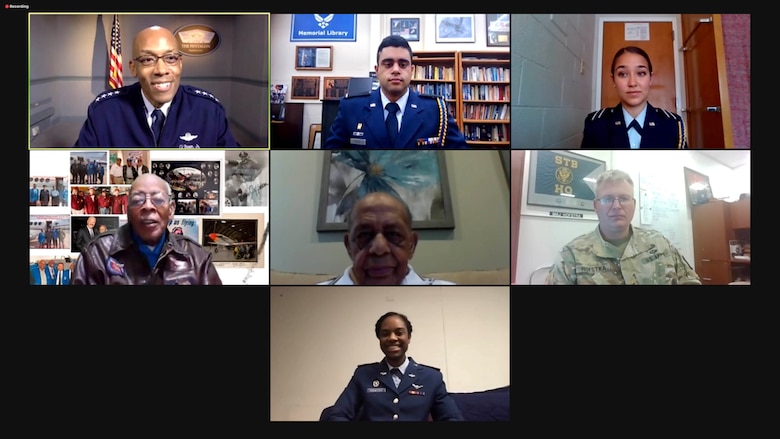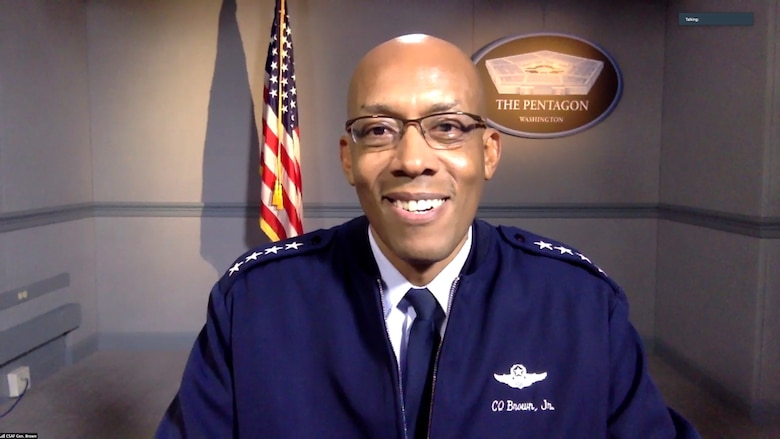The event was part of the American Veterans Center's 23rd Annual Veterans Conference, which will premiere on Oct. 28. Present at the event were Tuskegee Airmen retired Lt. Col. (Dr.) Harold Brown and retired Lt. Col. Alexander Jefferson. Also in attendance were Reserve Officers' Training Corps and U.S. Air Force Academy cadets who participated in the discussion.
"It's very important for our service members - particularly our Airmen - to have an understanding of the history of our Air Force and those that came before us, and how you can rise to whatever the challenge may be and then be successful, and no one is more fitting than the two of you," Gen. Brown said. "I want to thank you for paving the way, not only for me, but for so many others that have the opportunity to serve."
According to the National Museum of the United States Air Force, the 99th Pursuit (later Fighter) Squadron was formed as the result of a U.S. Army Air Forces experiment when the U.S. military was racially segregated during World War II. The squadron was comprised of black Airmen, called Tuskegee Airmen, who "demonstrated conclusively that African Americans - if given equal opportunities and training - could fly in, command and support combat units as well as anyone." They "served with distinction in combat, and contributed to the eventual integration of the U.S. armed services, with the U.S. Air Force leading the way."
"I was a (young kid) when I joined … it wasn't until I got older that I realized we had really done something wonderful and made an accomplishment here," Lt. Col. (Ret.) Brown explained. "I reflect and I think if we hadn't performed the way that we did, I don't think that Truman would have integrated us … I think it was primarily because of our success as Tuskegee Airmen."
The roundtable highlighted the Tuskegee Airmen's achievements and legacy of breaking barriers.
The cadets were given the opportunity to ask the Tuskegee Airmen questions on topics ranging from their experiences during the war to life after departing the military.
During the war, Lt. Col. (Ret.) Brown was shot down on his 30th combat mission and held as a German prisoner of war for two months while Jefferson was shot down during his 19th combat mission and held as a German POW for eight months.
"Can you imagine 72 P-51s in the air over something like 500 B-17 (and) B-24s? The sky was completely covered literally everywhere and, to me, it was a big show," Jefferson said as he reminisced about his first combat mission. "To tell you the truth: I enjoyed it, I had a hell of a good time."
Gen. Brown along with the ROTC and USAFA cadets expressed their gratitude for the opportunity to speak with these trailblazers, underscoring their mark on the diversity of today's Air Force.
"Mr. Jefferson and Mr. Brown, you are the shoulders we stand on," Gen. Brown said during his closing remarks. "It's not just the time you spent with us today, it's the service you did many years ago that paved the way for many."

Air Force Chief of Staff Gen. Charles Q. Brown, Jr. interviewed two Tuskegee Airmen, during a virtual roundtable, Oct. 20, 2020, in observance of the 75th anniversary of the end of World War II. The event was part of the American Veterans Center's 23rd Annual Veterans Conference, which will premiere on Oct. 28. (U.S. Air Force graphic)

Air Force Chief of Staff Gen. Charles Q. Brown, Jr. interviewed two Tuskegee Airmen during a virtual roundtable, Oct. 20, 2020, in observance of the 75th anniversary of the end of World War II. The event was part of the American Veterans Center's 23rd Annual Veterans Conference, which will premiere on Oct. 28. (U.S. Air Force graphic)






